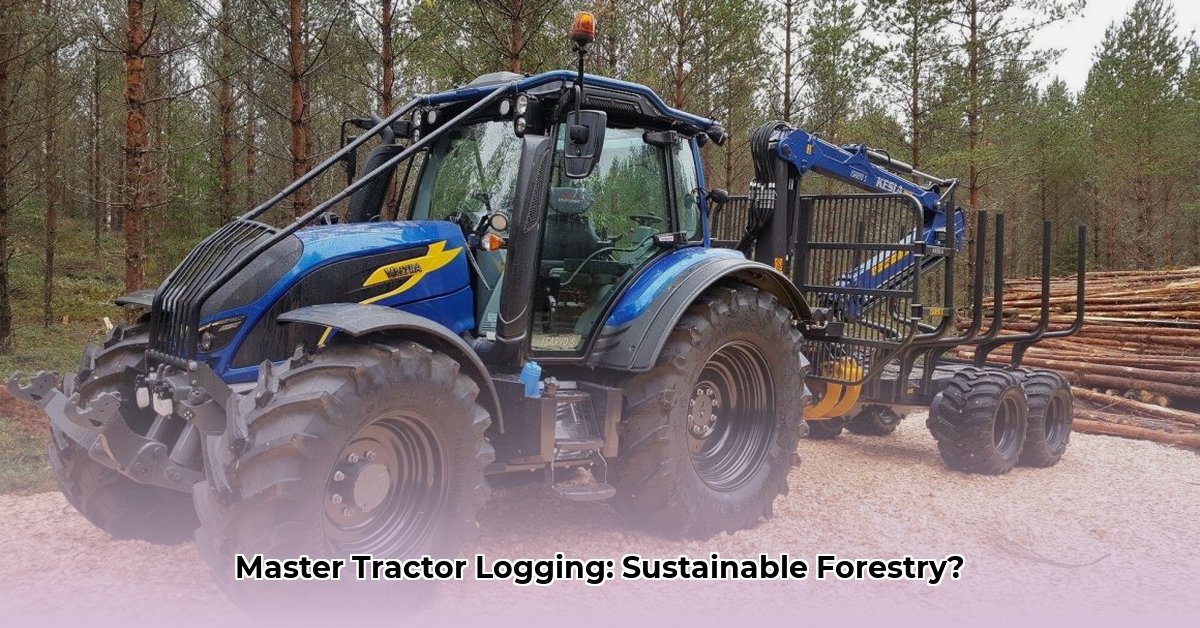
Tractor logging offers a sustainable and potentially cost-effective approach to timber harvesting, particularly for smaller operations or those prioritizing minimal environmental impact. This guide provides a practical, step-by-step approach to adapting agricultural tractors for sustainable logging, covering equipment selection, modification, safe operating techniques, maintenance, and regulatory compliance. For more detailed information on tractor logging equipment, see this helpful resource.
Essential Equipment: Building Your Logging System
Transforming your tractor into a logging machine requires specialized equipment. The core components are the winch, grapple, counterweights, and essential safety features.
Winch Selection: Power and Control
The winch is the heart of your system. Choose between manual winches (affordable but labor-intensive) and wireless winches (more expensive but offering greater convenience and control, especially in challenging terrain). Consider the winch's capacity (pounds or kilonewtons) and its compatibility with your tractor's power take-off (PTO) or hydraulic system. Brands like Tajfun (high-quality, higher cost) and Farmi/Fransgård (budget-friendly options) offer a range of choices; selecting the right one significantly impacts efficiency and safety. Do you need the precision of wireless control or the cost-effectiveness of a manual system? This crucial decision directly affects your operational efficiency.
Grapple Selection: Size and Efficiency
The grapple's size directly impacts efficiency. A grapple too small requires multiple passes, while one too large can lead to instability. Match grapple size to the average diameter of your logs. Consider durability and design for easy log handling and secure gripping.
Counterweights: Stability and Safety
Counterweights are essential for preventing tipping, especially when under load. Their weight must counterbalance the winch's pulling force. Consider suitcase weights or a front-end loader setup for optimal stability. Insufficient counterweight is a major safety hazard. How much weight is needed depends on the winch and the size of the logs.
Safety Equipment: Protecting People and Machines
Safety should be paramount. A sturdy canopy protects the operator from falling debris. Underbody shielding safeguards the tractor's vital components (engine, transmission, hydraulics) from damage during log extraction. Valve protection guards prevent hydraulic fluid leaks. Investing in robust safety features is an investment in both your equipment and your well-being.
Adapting Your Tractor: A Step-by-Step Guide
Converting your agricultural tractor for logging requires careful planning and execution. Here's a detailed, step-by-step guide:
- Tractor Assessment: Evaluate your tractor's horsepower and three-point hitch (3PH) capacity to ensure it can handle the anticipated loads. Consult your tractor's manual for specifics.
- Winch Installation: Securely mount the chosen winch to the 3PH according to the manufacturer's instructions. Proper installation is essential for functionality and safety.
- Grapple Installation: Install the grapple, ensuring proper integration with the tractor's hydraulic system. Correct hydraulic connections are crucial for operation.
- Counterweight Installation: Add counterweights for stability; ensure even distribution. Overlooking this step can lead to dangerous situations.
- Safety Feature Installation: Install and secure protective features: canopy, underbody shielding, and valve guards. This step enhances both safety and equipment lifespan.
- Testing and Refinement: Thoroughly test your modified tractor in a controlled environment before tackling actual logging. This helps identify and correct any issues early on.
Mastering Tractor Logging Techniques: Efficiency and Safety
Efficient and safe log skidding is crucial. Follow these best practices:
- Strategic Route Planning: Plan routes to minimize soil damage and environmental impact. This includes considering water flow and erosion prevention.
- Secure Log Handling: Always secure logs firmly in the grapple to prevent accidents and damage. Improper securing is a major cause of incidents.
- Controlled Movements: Avoid sudden movements; maintain slow, controlled speeds to minimize soil compaction and damage to remaining trees.
- Terrain Awareness: Adjust speed and approach to the terrain's challenges; careful navigation prevents equipment damage and accidents.
Maintenance and Safety: A Preventative Approach
Regular maintenance is essential for preventing costly downtime and accidents. Establish a routine including:
- Daily Equipment Checks: Inspect fluid levels, tire pressure, and winch cable before each use. This preventative maintenance saves time and money in the long run.
- Winch Maintenance: Lubricate moving parts and inspect cables for wear; replace worn components immediately. Regular lubrication extends the lifespan of your winch.
- Hydraulic System Checks: Inspect for leaks; maintain proper fluid levels and pressure. Hydraulic system failures can halt operations.
- Personal Protective Equipment (PPE): Always wear appropriate safety gear, including safety glasses, gloves, sturdy footwear, and hearing protection.
Regulatory Compliance: Know Your Local Laws
Before starting, thoroughly research and comply with all applicable local, regional, and national regulations concerning logging practices. This involves permits, environmental impact assessments, and equipment standards. Consult your local forestry agency for specific requirements in your area. Ignoring regulations can result in costly penalties.
Case Study: [Insert successful real-world example of tractor logging operation here, highlighting efficient and safe practices. Include details about location, tractor type, equipment used, and results.]
This guide empowers sustainable logging practices, but remember, safe and responsible operation is your utmost priority. Always prioritize safety, and diligently follow best practices outlined here.